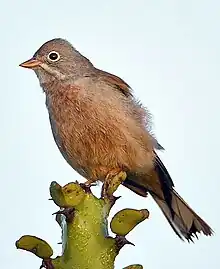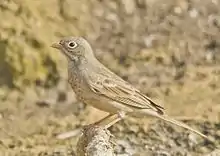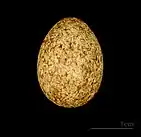Grey-necked bunting
The grey-necked bunting (Emberiza buchanani), sometimes referred to as grey-hooded bunting (a name also in use for chestnut-eared bunting[3]) is a species of bird in the family Emberizidae. It breeds along a wide distribution range from the Caspian Sea to the Altai Mountains in Central Asia and winters in parts of Southern Asia. Like other buntings it is found in small flocks.
| Grey-necked bunting | |
|---|---|
 | |
| Scientific classification | |
| Domain: | Eukaryota |
| Kingdom: | Animalia |
| Phylum: | Chordata |
| Clade: | Dinosauria |
| Class: | Aves |
| Order: | Passeriformes |
| Family: | Emberizidae |
| Genus: | Emberiza |
| Species: | E. buchanani |
| Binomial name | |
| Emberiza buchanani | |
| Synonyms | |
| |
Description

This bunting has a long pink bill and is greyish above. The male has a distinctive white eye-ring that stands out in contrast to the grey hood. The chin and throat are whitish pink and are bordered by grey malar stripes. The underparts are pinkish brown. The female is duller but the moustachial stripe can appear more noticeable. The outer tail feathers are whitish.[3][4]
The species was described by Edward Blyth based on a drawing by Francis Buchanan-Hamilton after whom the species is named.[5] It has been suggested that the actual date of the description was 1845 due to delays in the publication of the journal of The Asiatic Society.[6] A supposed type specimen in the Indian Museum was never located.[7]
In winter it makes a short subdued click note but the song is a metalling jingle made of swee-swee notes ending with a dzwe-ee-dul.[8]
Three subspecies are noted nominate buchanani, neobscura, and ceruttii.[9]
Habitat and distribution

This bunting is found mainly in dry and open habitats, often stony, scrubby hillsides covered with low thorn scrub. Birds that breed in the Baluchistan region winter in India moving through Gujarat in September and returning in March to their breeding grounds. It is found in Afghanistan, Armenia, Azerbaijan, Bhutan, Nepal, China, Hong Kong, India, Iran, Israel,[10] Kazakhstan, Mongolia, Oman, Pakistan, Russia, Syria, Tajikistan, Turkey, Turkmenistan, and Uzbekistan.
It is an extremely rare vagrant north of its breeding range, with recent records from Finland and the Netherlands, though wanderers may be overlooked due to its similarity, in non-breeding plumage, to the closely related and far commoner ortolan bunting.
They winter in parts of Africa, West Asia, and parts of South Asia as far south as Sri Lanka.[11]
Its natural habitat is temperate grassland mainly below 7000 ft.[12] In winter it is found in weedy or stubbly fields. It nests on the ground under some overhanging vegetation. The nest is lined with grass and hair. The song given from a perch is a series of short and shrill notes that increase in volume.[3]
A tick Hyalomma turanicum has been recorded on birds from Kazakhstan.[13]
Claud Ticehurst noted that males and females migrated separately.[14]
References
- BirdLife International (2017). "Emberiza buchanani". IUCN Red List of Threatened Species. 2017: e.T22720909A111135183. doi:10.2305/IUCN.UK.2017-1.RLTS.T22720909A111135183.en. Retrieved 11 November 2021.
- Blyth, E (1844). "Synopsis of the Indian Fringillidae". Journal of the Asiatic Society of Bengal. 13: 944–963.
- Rasmussen PC; JC Anderton (2005). Birds of South Asia: The Ripley Guide. Volume 2. Smithsonian Institution & Lynx Edicions. pp. 553–554.
- Oates, EW (1890). Fauna of British India. Birds. Volume 2. Taylor and Francis, London. p. 258.
- Hellmayr CE (1929). "Birds of the James Simpson-Roosevelts Asiatic Expedition". Field Museum of Natural History, Zoological Series. 17 (3): 61.
- Dickinson, E.C.; A. Pittie (2006). "Systematic notes on Asian birds. 51. Dates of avian names introduced in early volumes of the Journal of the Asiatic Society of Bengal". Zool. Med. Leiden. 80 (3): 113–124.
- Sclater, WL (2008). "On the Indian Museum and its collection of birds". Ibis. 4 (series 6): 65–87. doi:10.1111/j.1474-919X.1892.tb01187.x.
- Ali, S; SD Ripley (1999). Handbook of the Birds of India and Pakistan. Volume 10 (2nd ed.). New Delhi: Oxford University Press. pp. 230–232.
- Paynter Jr. RA, ed. (1970). Check-list of birds of the World. Volume 13. Cambridge, Massachusetts: Museum of Comparative Zoology. p. 13.
- Yosef R (2001). "Status and migration characteristics of buntings (Emberizidae) in Eilat and in Israel" (PDF). In Tryjanowski P, Osicjuk TS, Kupczyk M (eds.). Bunting studies in Europe. Bogucki Wyd Nauk, Poznan. pp. 11–18. Archived from the original (PDF) on 2008-11-21.
- C. D. Kaluthota; Dammithra Samarasinghe; Dilshan de Silva; Hasith de Silva (2009). "First Record of the Grey-necked Bunting Emberiza buchanani from Sri Lanka" (PDF). Malkoha. 30 (1): 4. Archived from the original (PDF) on 2016-03-03.
- Carruthers, Douglas (1949). Beyond the Caspian. Oliver and Boyd. p. 107.
- Hoogstral, Harry (1956). Ticks of the Sudan, Volume 1. US Naval Medical Research Unit 3, Cairo. pp. 528–530.
- Baker, ECS (1926). Fauna of British India. Birds Volume 3 (2nd ed.). Taylor and Francis, London. pp. 208–209.
